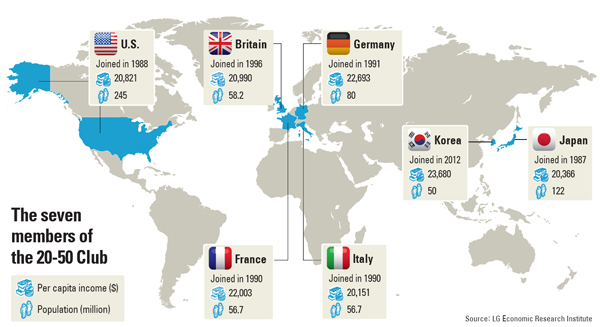Finding the engines for the future

Korea is at the top of its game.
The country’s credit rating is on par with that of Japan for the first time ever. In less than three years, the country’s tech giant Samsung Electronics has become the biggest player in one of the most important tech products - smartphones and other mobile devices - at least in terms of units sold.
And for the icing on the cake, an obscure Korean rapper got the world dancing and laughing with “Gangnam Style” - and even singing in Korean.
But analysts say after patting its own back, Korea needs to think hard and long about sustaining its success. The euro zone crisis and the sputtering Chinese economy are timely reminders that success can quickly turn to pain for an economy so dependent on exports.
And across the Korea Strait, a lesson in economic stagnation and fall from economic power exists in Japan, whose rise was very similar to Korea’s.
To continue to grow and prosper, Korea needs to fix some of the structural problems that have endured through the decades, such as the overreliance on exports, an aging society and a relative lack of openness to the outside world.
And it badly needs to find new “engines” of growth - particularly ones that emphasize innovation rather than copying products invented elsewhere.
“What Korea needs to do is an attitude that pursues innovation rather than copying others,” says Guy Sorman, a French professor, author and public intellectual in economics and philosophy, who visited Seoul last month for the publication of the Korean version of his latest book “Journal d’un Optimiste.”
On June 23, Korea became the seventh country to join the so-called “20-50 Club,” the advanced nations on the planet with populations over 50 million and per capita incomes over $20,000.
The last country to join the club was the United Kingdom in 1996. The other members are Japan, the United States, France, Italy and Germany.
In June, Korea’s population exceeded 50 million for the first time. Its per capita income in 2011 was $22,489.

According to a report by Kim Hyung-joo, a research fellow at the LG Economic Research Institute, being a 20-50 club member is a major challenge if you consider that 53 countries have per capita incomes exceeding $20,000 and 26 countries have populations over 50 million.
“Not only reaching the income target, but also meeting the population threshold is important for a country to become an influential player on the international stage,” Kim says. “Korea could hit both targets owing to an openness that accepts diversity, an adequate size of the domestic market and resilience.”
Such characteristics can be seen in a microcosm with Samsung Group, the country’s No. 1 conglomerate, and its success in the mobile devices industry. Samsung was far behind the leading cellphone makers, Nokia and Motorola, until it made an aggressive push with its Anycall model, the precursor to the smartphone.
Samsung could develop Anycall phones that were faster and lighter than its rivals because it had an adequate sized domestic market that served as a testing ground for its products.
“Korean consumers are very picky,” says Park Seung-ho, principal engineer of the Global Customer Satisfaction Team at Samsung. “They want a cellphone that connects everywhere, so we had to keep improving to meet such high standards demanded by consumers.”
It was slow to recognize the iPhone as a game changer, and didn’t come out with the Galaxy S smartphone until early 2010, almost three years later. It is now the No. 1 selling model in the world.
“We should always be open to let in others and embrace what they have,” says Park.
The next goal of Korea is to reach $30,000 in per capita income. But Korea faces three major obstacles to that goal: the over-reliance on exports, its aging society and an absence of new industrial engines for sustainable growth.
For the six other countries in the 20-50 club, it took four to 14 years to go from $20,000 to $30,000.

It will take at least five years for Korea to reach that level with current economic growth patterns, according to the LG Economic Research Institute’s Kim. And that’s without factoring in the current economic slowdown.
“The euro zone crisis and slowdown in the Chinese economy will make it difficult for Korea to move onto the next stage,” Kim says. “Due to prolonged, bad economic conditions, many believe that there will be no eighth member of the 20-50 club for a long period of time, which means Korea may be the last.”
According to data by the Organization for Economic Cooperation and Development, Korea’s reliance on trade in 2011 was the highest among OECD members, which means the economy is more vulnerable to external uncertainties.
“If exports stop growing, the Korean economy would stop growing, too,” says Kim Chang-bae, a researcher at Korea Economic Research Institute.
Another task is to maintain its population of 50 million. According to Statistics Korea, the Korean population is forecast to hit a peak of 52 million in 2030 and then dip back to 49 million by 2045.
Consistently low birth rates and a rapidly aging population will drain the pool of economically active Koreans.
Korea’s birthrate currently stands at 1.24 births per woman, which is up from 1.08 in 2008. Although the figure improved, it is the second-lowest among OECD member countries, above only Latvia.
The statistics bureau predicts that the so-called “productive population group” that is capable of participating in economic activities will peak at 37 million in 2016 and decline by four million between 2017 and 2030 to reach 33 million. Then, it will continue to decline.
“We are in urgent need of measures to prevent the accelerating decrease in the productive population group,” says Woo Ki-jong, commissioner of Statistics Korea.
Innovation, creativity and services are the key concepts for sustainable growth, experts say.
Another researcher from the LG Economic Research Institute, Yoon Sang-ha, argues that the Korean economy needs to lessen its dependence on manufacturing in order to take a second leap forward.
“The country has adopted a manufacturing-focused growth plan in order to achieve growth in a short period time,” Yoon says.
“In order to bring the economy to a higher level, the service industry should be developed as much as the manufacturing sector has been,” Yoon says.
Industry leaders point out Korea’s lack of competitiveness in innovation and creativity.
“In the recent legal battles between Apple and Samsung, it was obvious that Apple fought with its innovation capability while Samsung fought back with its manufacturing excellence,” says Christopher S.W. Khang, CEO of GE Korea.
“Korea is called an IT powerhouse, but it would be more accurate to call it a hardware-centered IT powerhouse,” he says. In terms of software and content, Korea doesn’t come anywhere near the Apple level, he says.
“A lesson from the Samsung-Apple patent conflict is that Korean manufacturing companies need to get away from the mold of hardware-based competitiveness to become aware of the need for a new business strategy [aimed at innovation],” he adds.
By Song Su-hyun [ssh@joongang.co.kr]










with the Korea JoongAng Daily
To write comments, please log in to one of the accounts.
Standards Board Policy (0/250자)